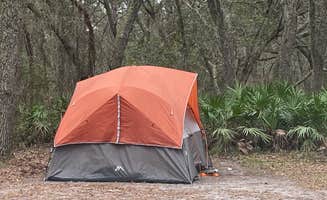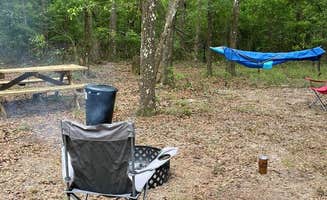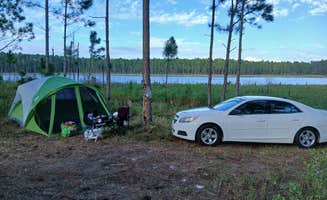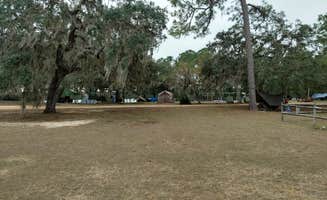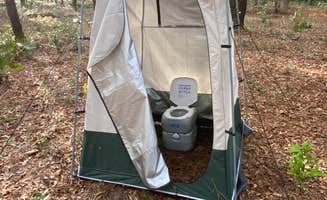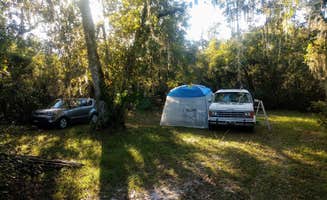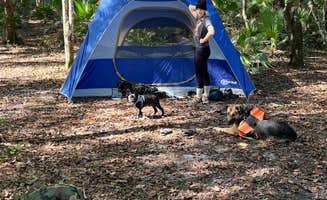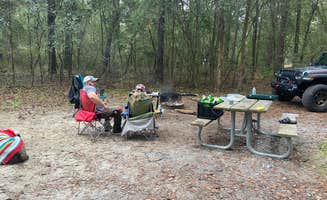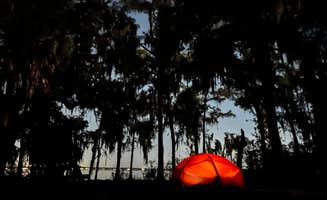Primitive camping options abound near Micanopy, Florida, where the terrain consists largely of flat pine forests and wetlands at elevations between 40-100 feet. The region sits at the edge of the Ocala National Forest, approximately 25 miles south of Gainesville and 85 miles northwest of Orlando. Campers often encounter sandy soil conditions and must contend with seasonal insect populations that peak during summer months.
What to do
Hiking nearby trails: Etoniah Creek State Forest offers multiple hiking options including the George's Lake trail with lake observation deck. According to a reviewer, "Just off the Palatka-Lake Butler Bike trail. Campgrounds are About 4 miles in on bikeable hard roads. Six Sites have picnic tables, lots of room, fire ring with grate, bbq grills, a latrine nearby."
Water activities: At Potts Preserve - River Primitive Campground, campers can access the river directly from the campground area. A camper notes: "It's still a great part of the river, there is access to the river from the primitive area and there is a ramp sort of. The float into Gum Slough is right there at the edge of the campground, simply an awesome trip."
Cycling adventures: Nearby paths include the Palatka-Lake Butler Bike trail. At Bowman's Landing, a reviewer mentioned their children's favorite activities: "My son's favorite part was riding around on the provided bicycles and playing darts & cornhole by the communal fire pit."
Wildlife observation: Multiple preserves offer wildlife viewing opportunities. For example, at Flying Eagle Preserve, a visitor noted, "Stayed here on 3 separate occasions. Each time not a single soul to be found with the exception of the passing airboats. Site was very spacious and private."
What campers like
Privacy between sites: At Jennings State Forest, campers appreciate the natural separation between camping areas. One reviewer noted: "The sites were close as you would normally get in an established campground but there was plenty of brush to separate each site." Another camper mentioned: "With 16 campsite each being semi private you will love the sounds of the wind in the trees and hawks flying over."
Free camping options: Several preserves offer no-cost camping with reservations. At Flying Eagle Preserve, a visitor shared: "You make a free reservation and receive the gate code to get in. We had a wonderful time and ran into very few people. Pretty much the only thing we heard were airboats."
River access: Multiple sites provide direct water access. A camper at Potts Preserve mentioned: "We really enjoyed our stay at this site. It was nice and quiet. You can't drive up to the river view campsites. So cart would be useful for that reason."
Proximity to trails: Many campsites connect directly to trail systems. At Jennings State Forest, a reviewer stated: "We hiked the beach pioneer trail and really enjoyed ourselves. The campsite is about a mile in and has a picnic table and fire ring. There is a stream nearby for water."
What you should know
Reservation requirements: Most primitive sites require advance booking. For Caravelle Ranch Wildlife Management Area, a reviewer noted: "This very unassuming county-run wildlife area sits on 13,000+ acres of thick wilderness and wetlands offering a number of different hiking trails."
Navigation challenges: Standard GPS often fails in these remote areas. For Flying Eagle Preserve, a camper advised: "GPS had a hard time getting there so I am going to include directions it's super easy... not so much if you follow Google though! Google will try to have you going through roads that don't go through."
Drinking water access: Many sites lack potable water. At Lake Delancy East, a visitor noted: "Very nice Primitive campground. Has vault bathrooms that are kept pretty clean. No running water but has a hand pump well."
Site accessibility changes: Some locations have modified vehicle access. At Potts Preserve, a camper reported: "The large open pasture/meadow is no longer a vehicle area, same with the 5 sites within that area. There is a designated area to leave vehicles, and the sites on the river are walk in only."
Airboat noise: Preserves near waterways often experience boat traffic. At Flying Eagle Preserve, a reviewer mentioned: "The only noise pollution is from air boats on the nearby swamp river, but this dies down at maybe 10 or 11 pm ET and mostly only on weekend nights."
Tips for camping with families
Beginner-friendly locations: For the best tent camping near Micanopy with children, consider sites with basic amenities. At Lake Delancy East NF Campground, a camper reported: "Spent the weekend after Thanksgiving here. LOVED it. Just two of us, car camping and relaxing. The Florida trail is close by."
Activity options: Look for campgrounds with built-in recreation. At Bowman's Landing, a parent shared: "We had the pleasure of visiting recently, and to my surprise this small campground exceeded my expectations! I traveled with two children, and they had a blast the entire time!"
Wildlife precautions: Teach children proper wildlife safety. One camper at Lake Delancy East noted: "Have seen Black Bears but no problems," indicating wildlife encounters are possible but typically not threatening when proper precautions are taken.
Insect protection: Ticks and other insects are common in Florida wilderness areas. A camper at Flying Eagle warned: "Lots and lots of books though make sure you use protection," likely referring to ticks or other biting insects.
Tips from RVers
Generator considerations: For those needing power at primitive sites, plan accordingly. A Lake Delancy East camper advised: "Very Primitive grounds, No electric or running water, but not a lot of crowds. Want electric bring generator."
Access limitations: Many primitive campgrounds near Micanopy have restrictions for larger vehicles. At Jennings State Forest, a camper in a van noted: "Apríl 9, 2021 Site #4 Camper Van GPS will not get you there. Go to Middleburg. Take Long Bay Rd. Left on Old Jennings Rd. Follow signs."
Weather preparedness: Florida's climate affects camping comfort significantly. A visitor to Jennings noted: "We went in March and it got pretty chilly at night, but the fire pit helped us stay warm."


